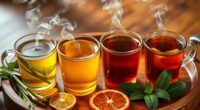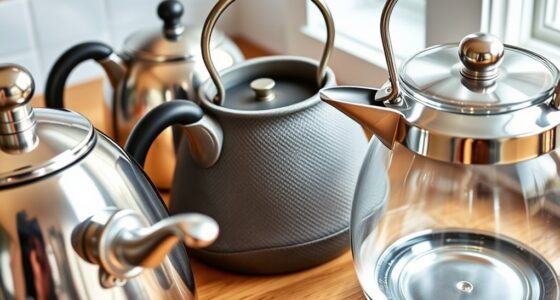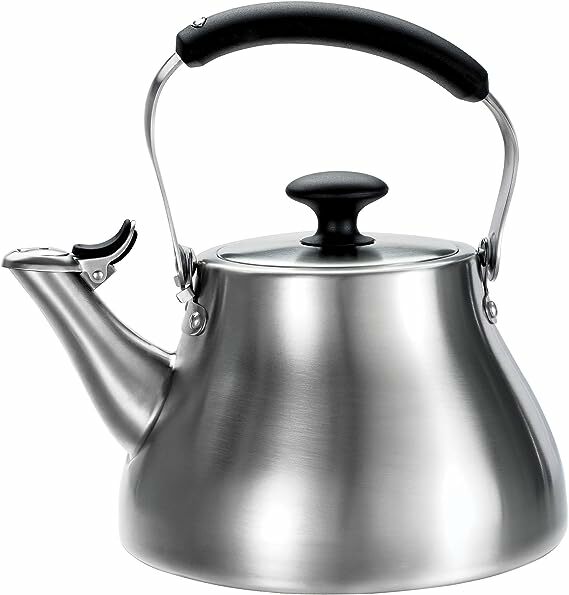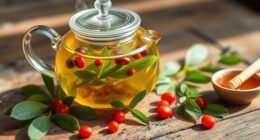Dragon kiln firing transforms teapots into unique works of art by blending traditional craftsmanship with complex glazing techniques. You’ll see vibrant colors, textured surfaces, and dynamic effects created through controlled atmospheres like oxidation and reduction. The kiln’s heat and airflow influence the glaze interaction, ensuring each piece is distinct. Exploring further reveals how these skilled processes preserve cultural heritage and elevate both aesthetic and functional qualities of each teapot.
Key Takeaways
- Dragon kiln firing involves precise control of oxygen and airflow, creating unique effects like crackles and smoky finishes.
- Traditional glazing techniques enhance teapots’ surface textures and glaze effects, reflecting centuries of craftsmanship.
- Firing in a dragon kiln requires patience and skill, contributing to each teapot’s distinctive appearance and artisanal value.
- Atmosphere variations during firing influence the final look, including earthy tones, glossiness, and crackled textures.
- The process preserves cultural heritage, showcasing the blend of functional craftsmanship and artistic expression in ceramic art.

Dragon kiln fired teapots are a striking example of traditional ceramic artistry, showcasing bold glazes and unique surface textures. When you handle these teapots, you’re experiencing centuries of craftsmanship that rely heavily on specific glazing techniques and firing atmospheres. The glazing process is essential because it defines the teapot’s final appearance, from glossy and smooth surfaces to more textured, matte finishes. Skilled artisans carefully choose their glazes, often applying multiple layers or using specialized techniques like dripping, brushing, or pouring to create dynamic effects. These techniques are not just decorative; they influence how the glaze interacts with the heat and atmosphere inside the kiln.
Dragon kiln teapots showcase centuries of craftsmanship through bold glazes and textured finishes.
The firing atmosphere within the dragon kiln plays a key role in determining the final look and texture of the teapot. You should understand that a dragon kiln’s environment isn’t simply about getting the temperature right; it’s about controlling oxygen levels, airflow, and the atmosphere’s overall composition. For example, reducing atmospheres—where oxygen is limited—can produce rich, earthy tones like deep browns and reds, often with smoky or crackled effects. Conversely, oxidizing atmospheres, with ample oxygen, tend to yield brighter, more vibrant glazes with a glossy sheen. The variability in firing atmospheres allows artisans to experiment and achieve a range of effects, ensuring each teapot is unique.
The craft of firing in a dragon kiln involves patience and precision. You, as a viewer or collector, get to appreciate the artistry behind each teapot’s surface. Every glaze application and firing atmosphere choice impacts how the piece looks and feels, making each one a distinctive example of traditional ceramics. Understanding these aspects deepens your appreciation for the skill and knowledge involved, recognizing that these teapots are not just functional objects but also works of art shaped by time-honored techniques and atmospheric mastery. Moreover, the firing techniques employed are often passed down through generations, preserving cultural heritage and ensuring the continued evolution of this craft.
Frequently Asked Questions
How Does the Dragon Kiln Influence Teapot Glaze Colors?
The dragon kiln influences teapot glaze colors by creating unique effects through its high-temperature environment. As the glaze melts during firing, the kiln’s heat causes natural color variation, resulting in unpredictable, beautiful hues. You’ll notice that the intense heat and specific atmosphere of the kiln enhance the depth and richness of the glaze, making each teapot one-of-a-kind with vibrant, varied colors shaped by the melting process.
What Are the Maintenance Requirements for Dragon Kilns?
Imagine your kiln is the original smartphone—requiring regular updates and care. To maintain your dragon kiln, you need to monitor firebrick longevity and guarantee proper kiln ventilation. Check firebricks for cracks or wear, replacing them as needed to prevent heat loss. Keep vents clear to promote airflow and even firing. Regular inspections, cleaning, and timely repairs help your kiln perform at its best, much like maintaining a trusted device.
Can Dragon Kiln Firing Be Replicated at Home?
You can attempt DIY kiln home firing, but replicating a dragon kiln’s unique atmosphere is challenging. For home firing, you’ll need a suitable DIY kiln that reaches high temperatures and maintains consistent heat. While it’s possible to mimic the firing process, achieving the same scale, airflow, and combustion conditions as a traditional dragon kiln is difficult. Be prepared for trial and error, and prioritize safety when exploring home firing options.
How Does Kiln Temperature Affect Teapot Durability?
You wonder how kiln temperature affects teapot durability. As temperature rises, glaze melting becomes more pronounced, creating a smooth, glossy finish, but excessive heat can weaken the clay’s structural integrity. Conversely, lower temperatures may preserve strength but risk incomplete glaze fusion. Striking the right balance guarantees your teapot remains resilient and visually appealing, with the perfect blend of glaze melting and structural integrity.
Are There Specific Teas That Enhance the Teapot’s Performance?
Certain teas can improve your teapot’s performance by enhancing tea flavor and promoting brewing harmony. When you use aged oolong or dark teas, they help season the clay, boosting flavor enhancement over time. Green teas, however, might not develop the same depth. By selecting specific teas and consistently brewing, you create a more seasoned, harmonious vessel, making each brew richer and more enjoyable for your palate.
Conclusion
As you marvel at the dragon kiln-fired teapots, remember that every sip you take carries centuries of craftsmanship and fiery passion. These pots aren’t just vessels—they’re relics of a timeless art, blending tradition with today’s flair. So, next time you brew your tea, imagine you’re part of history, like a knight of the Middle Ages discovering a modern marvel. Embrace this fusion of past and present, and let every cup be a toast to artistry’s enduring spirit.










